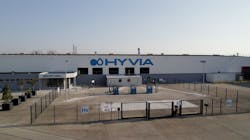Renault-Plug Power joint venture to begin production of H2 Fuel Cells for European Commercial Vehicle market
An industrial plant focused on creating hydrogen fuel cell modules for vehicles and electrolyzers is ready to begin production in France.
HYVIA, a joint venture between the Renault Group of automakers and fuel cell producer Plug Power, is completing the plant at Flins, Ile de France. The first step of manufacturing comes with HYVIA beginning assembly and testing of fuel cell modules based on Plug Power’s technology.
The 30-kW fuel cells are being created to power Renault’s Master H2-TECH portfolio of vans, cabs and buses. By the end of this year, HYVIA also intends to begin assembly of hydrogen refueling stations and production of H2 with the first on-site PEM (proton exchange membrane) electrolyzer.
"HYVIA plant is part of the Re-energy pilar of our strategic Refactory plant in Flins,” Luca de Meo, Renault Group CEO, said. “Its ramp up embodies Renault Group's strong ambitions in H2 mobility, complementary to electric mobility. It will contribute to increase local integration, creating value in France and Europe.”
Fuel cell technology combines hydrogen and oxygen with a catalyze to create electric charges which power a vehicle's electric motor.
The joint venture was started by Renault and Plug Power only nine months ago. The goal is reach 30 percent of the European H2-powered light commercial vehicle market by 2030.
“Plug Power is proud to see the assembly of its fuel cell here in France,” company CEO Andy Marsh said. “We have accelerated our growth with HYVIA, in partnership with Renault Group. Together, we’re taking meaningful steps to tackle climate change.”
New York-based Plug Power also has announced collaborations around green hydrogen production with ABB and Lhyfe in separate deals.
The transportation sector creates close to 30 percent of greenhouse gas emissions in the U.S. alone, according to the federal Environmental Protection Agency. Hydrogen does not emit carbon when burned but it must be created either by electrolyzers or steam reforming of methane gas.
About the Author
Rod Walton, EnergyTech Managing Editor
Managing Editor
For EnergyTech editorial inquiries, please contact Managing Editor Rod Walton at [email protected].
Rod Walton has spent 17 years covering the energy industry as a newspaper and trade journalist. He formerly was energy writer and business editor at the Tulsa World. Later, he spent six years covering the electricity power sector for Pennwell and Clarion Events. He joined Endeavor and EnergyTech in November 2021.
Walton earned his Bachelors degree in journalism from the University of Oklahoma. His career stops include the Moore American, Bartlesville Examiner-Enterprise, Wagoner Tribune and Tulsa World.
EnergyTech is focused on the mission critical and large-scale energy users and their sustainability and resiliency goals. These include the commercial and industrial sectors, as well as the military, universities, data centers and microgrids. The C&I sectors together account for close to 30 percent of greenhouse gas emissions in the U.S.
He was named Managing Editor for Microgrid Knowledge and EnergyTech starting July 1, 2023
Many large-scale energy users such as Fortune 500 companies, and mission-critical users such as military bases, universities, healthcare facilities, public safety and data centers, shifting their energy priorities to reach net-zero carbon goals within the coming decades. These include plans for renewable energy power purchase agreements, but also on-site resiliency projects such as microgrids, combined heat and power, rooftop solar, energy storage, digitalization and building efficiency upgrades.

